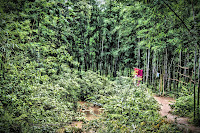My last full day in Myanmar, I was so exhausted from touring
every day that I really just wanted to be lazy and stay at the hotel, but the
guide had traveled almost two hours to take me out, so I finished breakfast and
jumped back into the boat (ok, slowly eased my way). Our first stop was the floating market. My
guide told me, “we are approaching the floating market, but most of it isn’t
floating anymore.” The only boat-borne merchants were the tourist souvenir
peddlers. All the other market-goers had gone on land.
 While visiting the market, we stopped at a large souvenir
shop to see the Padaung women that wear brass coils around their necks. “We
will see the Padaung ladies here, but they are not from here.” It turns out
they are brought in every day to work in the shop and let people take pictures
of them. They normally live in the Southern part of Shan State, but tourists
require special government permits to travel there, so they come to Inle Lake
to earn money posing for photos. The whole visit was beginning to seem a bit
comical; the jumping cat monastery where the cats don’t jump, the floating
market where the market doesn’t float, and the local ethnic tribe that isn’t
local.
While visiting the market, we stopped at a large souvenir
shop to see the Padaung women that wear brass coils around their necks. “We
will see the Padaung ladies here, but they are not from here.” It turns out
they are brought in every day to work in the shop and let people take pictures
of them. They normally live in the Southern part of Shan State, but tourists
require special government permits to travel there, so they come to Inle Lake
to earn money posing for photos. The whole visit was beginning to seem a bit
comical; the jumping cat monastery where the cats don’t jump, the floating
market where the market doesn’t float, and the local ethnic tribe that isn’t
local.
We then proceeded to a gold and silversmith shop, where
jewelers were toiling away making incredibly intricate gold and silver jewelry
and trinkets. One young man was making a series of increasingly large silver
rings shaped like fish scales that were eventually pieced together to form a
wiggling fish. I was dying to buy some of the things in the shop, but I was
down to my last $15 USD for my stay in Myanmar. I knew that I needed to have
dinner that night and possibly pay an airport departure tax in Yangon the next
day. I think it’s the first time I’ve been in a shop when I literally didn’t
have a single dollar to spare.
After the silversmith, we went out to the thousand stupa
pagoda. While it’s true that the thousand stupa pagoda doesn’t have a thousand
stupas, it’s not quite as funny because there are actually 1054. There
are two
paths up to the pagoda, one covered staircase directly to the top of the hill
and one that winds it’s way through the village and the forest along the river.
We took the latter, and it was a perfect choice. I was paranoid that a snake
might crawl out and attack me or fall from a tree at any moment, but we got to
see more locals this way instead of just souvenir shops that I could no longer
afford. One woman was making fresh rice crackers, and, for the cook inside me,
it was very exciting to watch. Here, the rice crackers aren’t fried like usual,
rather they are cooked under hot sand over coals. The old woman placed the
cracker dough on top of the sand and then scooped the sand over the cracker allowing
it to quickly puff and crisp up. After visiting half of the pagoda, the guide
suggested that I go around to the other side to see the rest of the stupas.
Tired, I told her, “I didn’t count on the first side, so we can just pretend I
saw all 1054.” 

 The next stop was another beautiful temple, where there were
five famous Buddha statues. “They are known for the five Buddha statues, but
you can’t see the Buddha statues anymore.” I was beginning to think this was
some giant scam, but it turns out the statues are still there and on display,
but worshippers have placed so much gold leaf on them that they have lost their
shape and look more like giant balls of gold. The five statues were always
considered important, and they are floated around the lake each year on a giant
royal barge for 18 days. Once, the barge capsized, and all of the statues fell
into the lake.
The next stop was another beautiful temple, where there were
five famous Buddha statues. “They are known for the five Buddha statues, but
you can’t see the Buddha statues anymore.” I was beginning to think this was
some giant scam, but it turns out the statues are still there and on display,
but worshippers have placed so much gold leaf on them that they have lost their
shape and look more like giant balls of gold. The five statues were always
considered important, and they are floated around the lake each year on a giant
royal barge for 18 days. Once, the barge capsized, and all of the statues fell
into the lake.
After an incredible lunch of local Inle food like a
caramel-like chicken with cashews, spicy tomato paste, local lake fish stuffed
with onions and tomatoes, fresh green bean salad, and a great pork curry, we
headed back to the hotel just in time for a major rain. I sat in my room
editing photos and watching the rain beat down on the lotus leaves.



















No comments:
Post a Comment